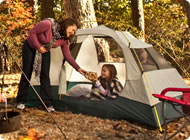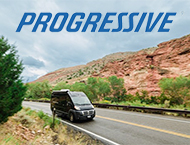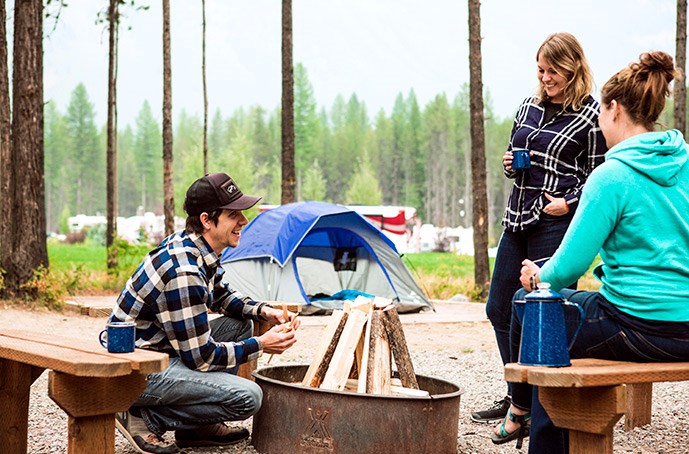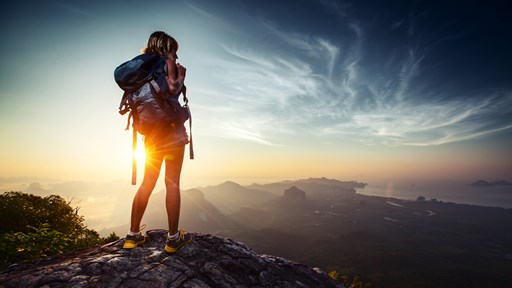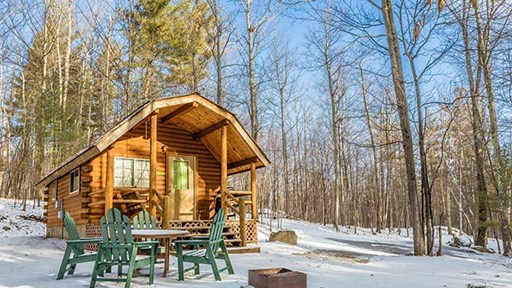Use these camping tips, tricks and hacks to make your next great outdoors adventure easier.
Camping connects you with the quiet majesty of nature, allowing you to recharge your batteries and relax with family and friends. For some, “roughing it” is all part of the fun — but why not allow a bit of homespun ingenuity to make things easier for you on your next camping trip?
Here are some of our top camping hacks to take along for the weekend. These camping tips and tricks are not only crafty, but they’re also extremely easy to implement. What’s best of all is that many of them will save you space, time, weight, and money.
1. Make a Lantern Out of a Headlamp and a Jug of Water
All you need is your headlamp and a gallon jug of water or large water bottle. Any translucent bottle will do, but the coolest effect comes from the type of plastic that is not completely transparent, but rather that slightly cloudy color that allows you to see water sloshing around inside.
When it gets dark, strap the headlamp to the side of the jug so that the beam is facing inward. The jug of water transforms into a cool, glowing orb that casts light in all directions! This works because the water in the jug spreads the light, which then is dispersed further by the milky plastic of the container.
This makeshift lantern works great anywhere you need ambient light. Whether you need to look for something inside your tent, clean up the picnic table, or start a campfire, your night just got a whole lot easier.
2. Glue Sandpaper Inside the Top of Your Match Holder for Easy Lighting and Waterproofing
Matches are an absolutely indispensable item when you’re camping, but it seems that all too often, things go wrong with them. They get wet, the case gets soggy, or the strike pad wears down until it is smooth. This camping hack ensures that your matches will be ready to strike when you need them.
Buy fine-grained sandpaper, preferably with adhesive on one side so that you can stick it to the matchbox. If not, some glue will do the trick. Attach the sand paper to the inside of the lid of a small waterproof container that will hold your matches.
The sandpaper will not only provide a large, coarse surface for striking, but it will also be protected by the waterproof container. No more soggy matches or wet or worn out strike pad!
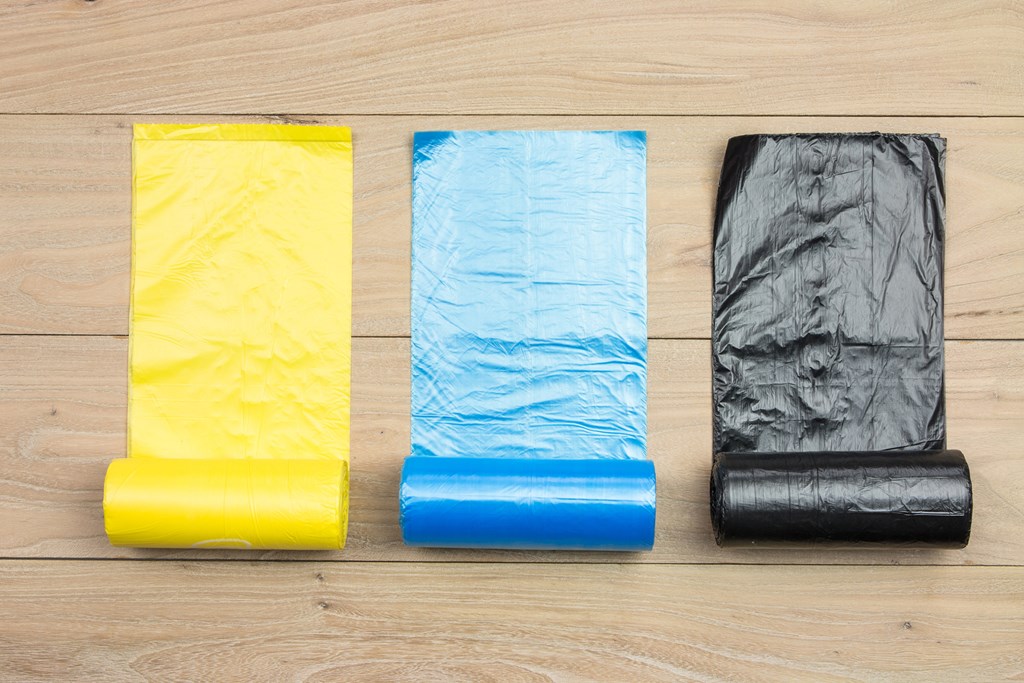
3. Line Your Bag with a Garbage Bag to Keep Contents Dry
Weather is everything when you’re camping, and a seasoned camper knows that you can never be too prepared for Mother Nature’s fickle moods. Once you’re warm and dry inside of your tent, there’s nothing to worry about — unless, of course, you can’t get warm or dry because your bag and all of its contents got soaked in the rain.
This trick offers the ultimate cost-to-benefit ratio: a single trash bag in exchange for warmth and dryness. Simply line the inside of your backpack with a trash bag before placing all of your items into it. For the cost of a trash bag — somewhere between a nickel and a dime — you have dry clothes and a dry sleeping bag for your trip, guaranteed.
Avoiding wet clothing is not just important for your comfort, but also for your safety. Wet clothing can cause you to get chilled very quickly, which can lead to illness, so take this simple step to avoid this issue!
4. Use Silica Gel Packets to Keep Your Camp Cookware Rust-Free Between Uses
You know those silica gel packets that seem to appear in every product? They are actually quite useful for sucking up moisture, especially in items that tend to rust. That’s why we recommend buying a pack of them, or collecting them from whatever packages you buy, as they may just save your cookware.
In an ideal world, we would dry our cookware completely and store it in a moisture-free environment between uses. But weather changes, basements grow damp and we sometimes dry our dishes in a rush before stuffing them in our bags — and that is where silica gel packets come in.
Using these packets keeps moisture from rusting away your cookware between uses. It’s disappointing to pull out your favorite bowl or skillet and find it spotted with rust, and this little trick will help prevent that altogether.
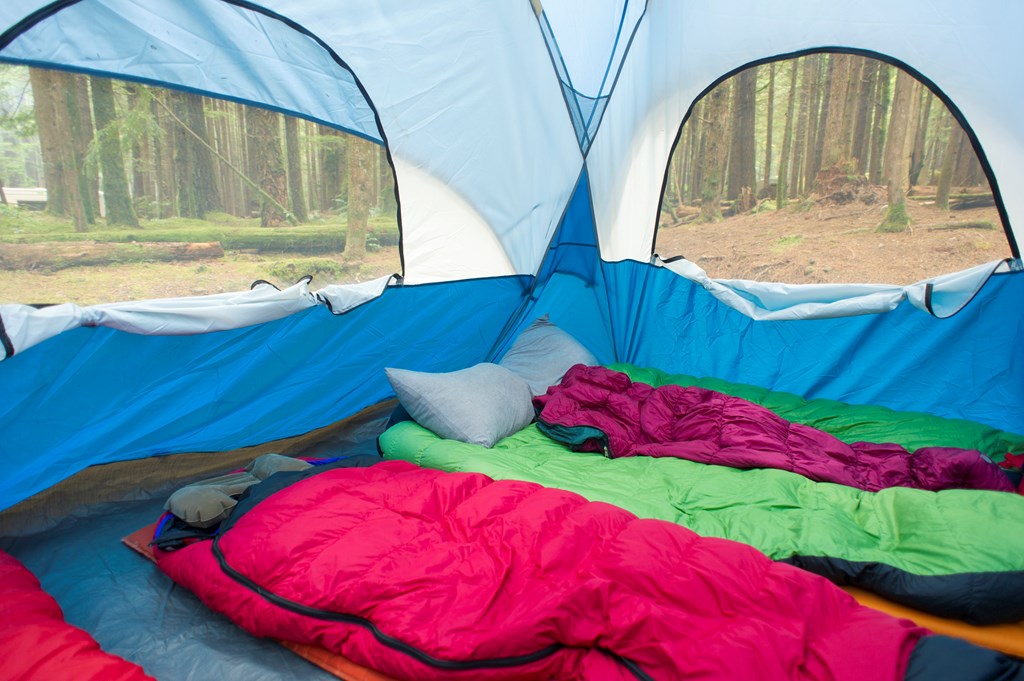
5. Pack Lighter by Using a Sleeping Bag Case Stuffed with Clothes as Your Pillow
Pillows are a matter of great personal preference. You may prefer yours soft or firm, feather or fluff, tempurpedic or light foam.
We can guarantee there’s one thing you don’t like about pillows, though, and that is the amount of space they take up in packing. Companies have come out with inflatable pillows that roll into impressively small spaces, but rolling around on air is rarely very comfortable. This often leaves us stuffing a pillow into our bag that takes up as much space as our clothing.
To form the ultimate camping pillow, take the case for your sleeping bag and stuff it full of your softest clothing. Make sure that sleeves are unrolled and socks are not too tightly balled up so that there are no pressure points, and simply shape the pillow to your liking. If you desire more support, then simply add more clothing! You’ll love the fact that you’ve saved that much space in your bag.
6. Bring Bread Tags to Use as Clothespins
Bread tags are one of the most underappreciated products around. They diligently hold bread bags closed, but rarely see any other purpose before being cast away. So next time you finish a loaf of bread, we challenge you to try them as clothespins on your next camping trip.
This is one of our best family camping hacks, since bringing enough clothespins for a family’s laundry can steal a good amount of real estate inside a bag. Bread tags are not only cheap, but they also take up minimal space in your pack.
So set a little dish aside and start collecting those bread tags. They will soon be doing their work in the sunshine, drying your clothes and keeping them securely fixed to the line.
7. Make a Makeshift Grommet by Tying Line Around a Rock Wrapped in a Tarp
Tarp grommets wear out quickly and often when you need them most. An immense amount of strain is placed on a relatively tiny ring, which often leads to the tarp fabric around it tearing loose.
If your tarp’s grommets have worn out, this camping hack is well worth remembering. Find a small, roundish pebble — about the size of a golf ball — and place it in the location where you’d need a grommet.
On the underside of the tarp, make an “O” with your finger and thumb, and push on the rock so that it and the tarp pass through the O. Pinch off the tarp with your finger and thumb, and tie a line tightly around the pinched tarp.
As another benefit, this makeshift grommet will hold far better than a regular one, since the strain from the line is being distributed over a larger section of the tarp.
8. Use Gallon Jugs of Water as Ice Packs in Your Cooler
Bringing ice on a camping trip can be difficult. It melts quickly and turns into a watery mess, meaning that any non-plastic food packaging will soon become soaked and soggy.
As an alternative to pouring ice into your cooler, freeze gallon jugs of water and put them in instead. They won’t crack when frozen, and these jugs have built-in room for expansion in freezing. Then, as the ice warms and turns into water, you’ll have drinking water ready without having to haul extra. Have smaller space? This works with individual bottles too!
There are two things to remember when packing water for a camping trip: water is absolutely essential, and it is also extremely heavy. Therefore, pack more than enough drinking water, but try not to pack water that will go to waste — like ice that will soon melt and become undrinkable. This hack helps with both points simultaneously by allowing your ice to become extra drinking water after it has done its job keeping your food cold.
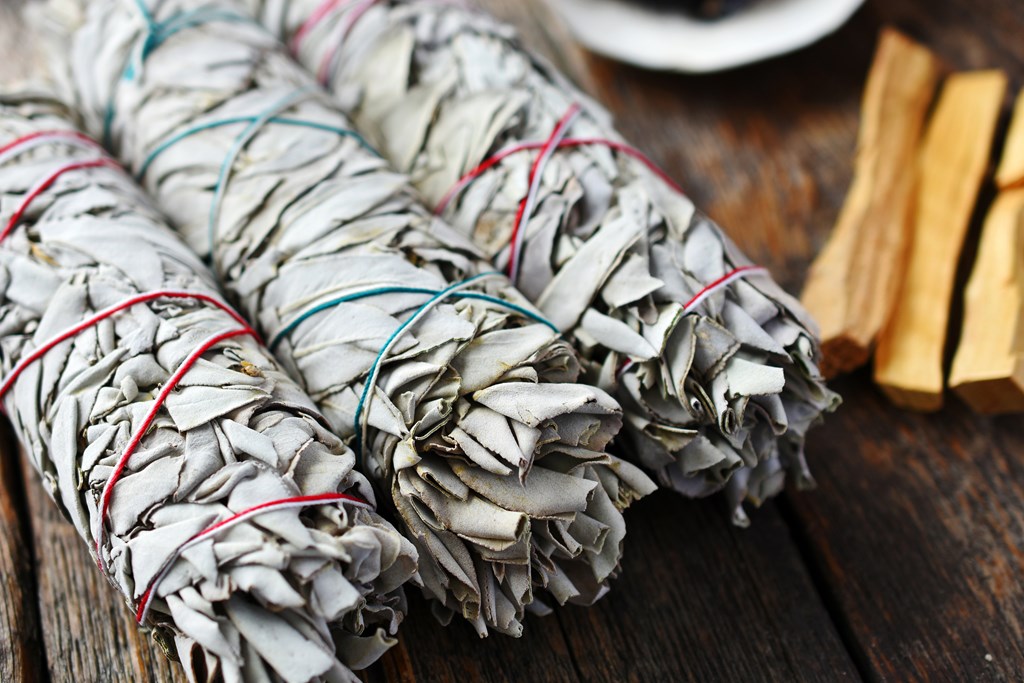
9. Burn Sage in Your Campfire to Help Repel Mosquitoes
Mosquitoes can dampen an otherwise great camping experience. Knowing how to repel them, even without slathering yourself in hazardous levels of bug repellent, is a great skill to have when camping.
Take along a few bundles of sage the next time you go camping. Then, when the sun is setting and the campfire is going, burn a bit of sage with your fire. Or for a longer-lasting effect, set the sage on fire and let it smolder and smoke by the edge of the campfire. Mosquitoes are naturally repelled by sage smoke, and you’ll find a lot less of them buzzing around you.
Remember that mosquitoes, while their presence may be felt at all times of day, are typically most active at dawn and dusk. It’s best to be prepared by having some burning sage ready at those times.
10. Corn Chips and Doritos Make Great Kindling If You Can’t Find Small Sticks
There are times when good kindling just isn’t easy to find, and we’re left eyeing those poor, undeserving items in our camping arsenal as flammable candidates. But there is good news — a handful of Doritos will do a beautiful job of starting a fire.
You may wonder how a food like Doritos could burst into flame when lit. It turns out that all of the starches, chemicals, oils, and flavors comprising this snack make it a prime candidate for combustion and it will work wonders at starting a fire.
While Doritos are recommended, most corn chips will suffice in a pinch. The corn oil in these chips is flammable and provides a steady burn that will allow you to get your fire started.
11. Melt and Seal Straw Sections to Store Spices and Other Small Ingredients
This one takes a bit more preparation than simply throwing some ill-fated Doritos into your bag, but it’s an immense space saver and makes camping trips a whole lot easier in both packing and unpacking.
Our culinary skills are often limited in the woods by a lack of seasonings and spices. No one really sells travel pouches of curry powder, chili powder, or rosemary, so we’re typically forced to settle for bottles of salt and pepper.
This hack involves taking plastic straws and cutting them into short segments, then melting one end with a candle and filling the straw piece up with a spice of your choice. If you want more of the ingredient, simply cut a longer length of straw. Then seal the other end and voila — you have a waterproof, ultra-portable selection of spices at hand in the woods.
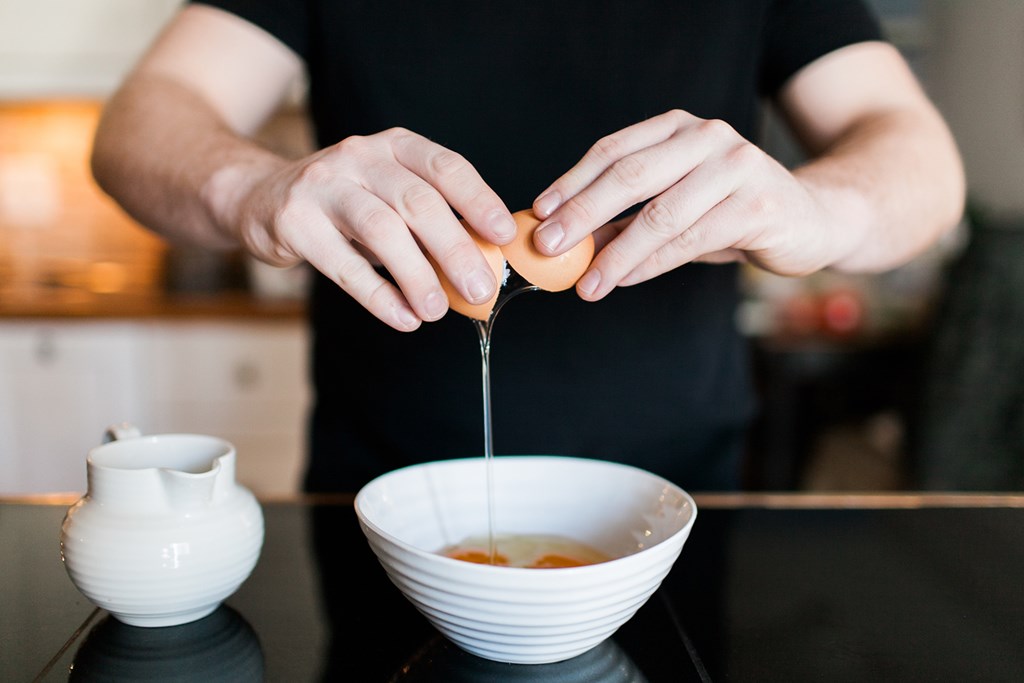
12. Crack Eggs Ahead of Time and Store Them in a Water Bottle for an Easy Breakfast
Bringing eggs on a camping trip is risky business. In the event that they crack, you lose the eggs and have a mess to contend with as well.
Try this campfire cooking hack instead. Crack eggs beforehand and store them in a water bottle. You can do this many different ways. If you know everyone will prefer scrambled eggs, you can whip the eggs and then store them in a large water bottle — you can even add milk, cheese, and seasonings if you’d prefer.
If you have a water bottle with a slightly larger opening, you could also gently crack eggs into it for fried eggs with intact yolks. Take several bottles for different meals, or use a larger bottle to pour repeatedly.
Be sure to store these in your cooler so they won’t spoil, and enjoy the ease of not toting fragile eggshells with you.
13. Fill a Bottle with Hot Water and Put It in the Foot of Your Sleeping Bag
With this trick, we take advantage of the heat-storing capabilities of water — this time, to bring some heat to our most remote extremities: our feet.
Feet seem to be the last part of the body to warm up when we snuggle into our sleeping bags. To combat this, take your Nalgene and fill it with hot water just before you retire for the evening. Toss it into the foot of your sleeping bag and enjoy the long-lasting warmth it offers.
Make sure to use a good-quality water bottle, as waking up to a wet bag is no fun. Furthermore, if the hard plastic of your water bottle is distracting you from falling asleep, try burying your water bottle in a couple of shirts to soften its presence in your sleeping bag.
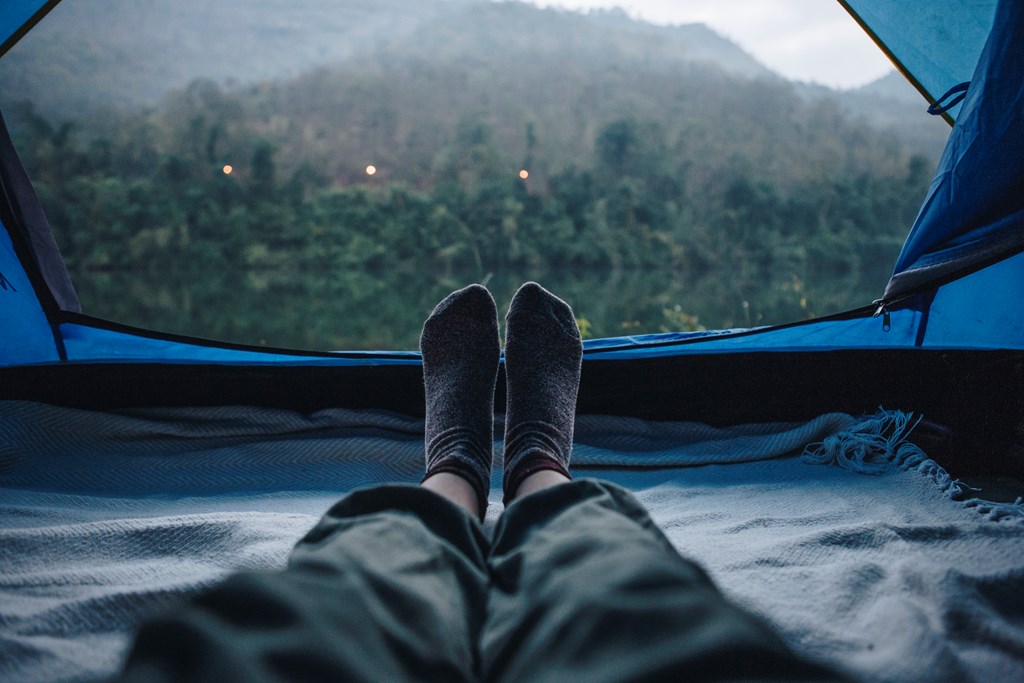
14. Keep a Pair of Socks for Sleeping Only
It’s hard to explain the mental and emotional comfort of a clean pair of socks. Putting one on can lift your morale tremendously. If you prefer to sleep in socks, try keeping one pair at hand for sleeping only. They do not have to be thick hiking socks — even thin ankle socks will do.
Even if you can’t shower, having a clean and dry pair of socks on while you sleep will help your body differentiate between the day’s activities and the solace of nighttime. Wearing them will not only be more comfortable, but it will also keep the dust, dirt, bark, splinters, pine needles, and whatever else is attached to your socks from entering your sleeping bag.
15. Dry Your Shoes Overnight by Removing the Insoles and Inserting Dirty Clothes into Them
Wet shoes are a serious discomfort while camping. If you are anywhere that is terribly humid, drying them out can also be a hard task.
Try removing the insoles from your shoes and setting them aside, then stuffing some dry, used clothing into the shoes themselves. Remember that moisture naturally spreads from wet to dry places, meaning that the moisture from your shoes will transfer into the dry clothing.
In the morning, dry the moist clothing by hanging it by the fire or strapping it on the back of your backpack to air dry.
16. Use Frisbees as Plates
Did you or a camping companion forget a plate? Fear not — simply give your Frisbee a quick wash, flip it over, and pile on the helpings. The lip of the Frisbee will keep any sauces in your food contained and at the end of your meal, it returns to its original purpose.
In fact, why not bring several Frisbees instead of hauling disposable plates? They may not be quite as space-efficient, but can be a lot more fun, and they serve dual purposes. Each member of the camping trip can carry their own Frisbee to balance out the load.
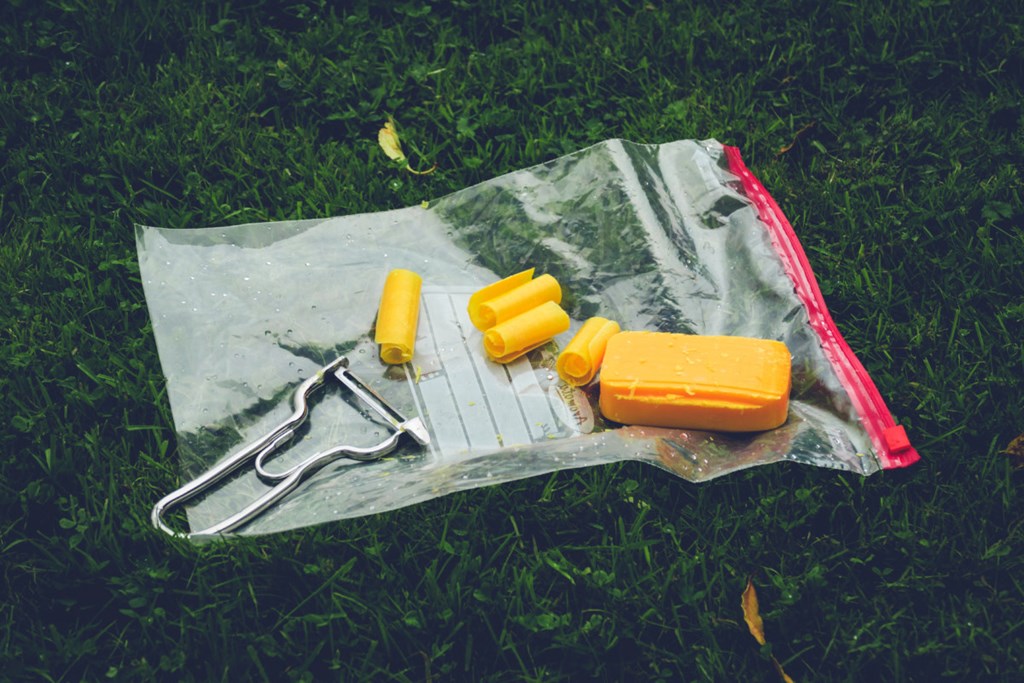
17. Use a Vegetable Peeler to Shave Strips of Soap for Single Uses
A bar of soap is a wonderful thing until you have to put it back in your bag. This usually ends with something in your bag getting soapy that wasn’t intended to be and assuming you are keeping it inside its own plastic bag, with a lot of soapy bubbles and wetness.
A convenient fix for the problem is using a vegetable peeler to slice off strips of soap to use each time you bathe. Store these in a single bag and simply grab one before heading off to shower. You can also grab one to wash your hands.
18. Loop Your Belt Around a Tree and Hang Some Hooks from It to Dry Your Cookware
Nighttime is for sleeping and recharging for the next day. If you’re a camper, you know that nighttime is also for drying stuff out. Shoes, clothes, bags, and yes, cookware. We already discussed using silica gel packets to wick water away from your pots and pans between uses. This nifty little camping hack will allow those pots and pans to dry overnight, making rust an even less likely scenario.
Take your belt and loop it around a tree. Then attach several pot-hanger hooks — some larger S hooks work wonderfully — to the belt. You can buy these almost anywhere that sells pots and pans or at your local hardware store. Hang your pots from the tree to dry overnight. Note that you should hang pots with the cooking surface facing away from the bark, as this will discourage any bugs from making a temporary home inside them.
19. Buy a Double Sleeping Bag
If you’re sharing a tent with your partner or someone you don’t mind being in the same sleeping bag with, then a duo sleeping bag is a great investment. Body heat is what keeps us warm at night, and a sleeping bag’s purpose is to reflect and retain that body heat. Therefore, one bag with two furnaces inside it is much better than two separate bags.
Sleeping bags are generally either synthetic fluff or down feathers, and each has its respective perks and disadvantages. Synthetic is cheaper and dries quickly, but takes up quite a bit of room. Down sleeping bags are costlier and retain moisture, but can compress into remarkably small shapes for packing and are generally warmer. A twin sleeping bag filled with down will not only keep you warmer, but can be stuffed into a small, portable sack to make transporting it a breeze.
Reserve Your Next Campsite Today to Try Out These Hacks
Are you already planning your next camping trip? If so, reserve a site at a KOA campground today and start putting these camping hacks to good use.
About the Author: Kampgrounds of America
Kampgrounds of America is the largest system of open-to-the-public campgrounds in the world, with over 500 locations across the United States and Canada. Founded in Billings, MT in 1962, KOA’s family of campground brands – KOA Journey, KOA Holiday and KOA Resort – today serve more than a million camping families each year. KOA is dedicated to “connecting people to the outdoors and each other” by providing people with a variety of camping experiences and the information they need to make the most of their camping trip. Read more of their camping and travel resources by visiting KOA.com/blog.











